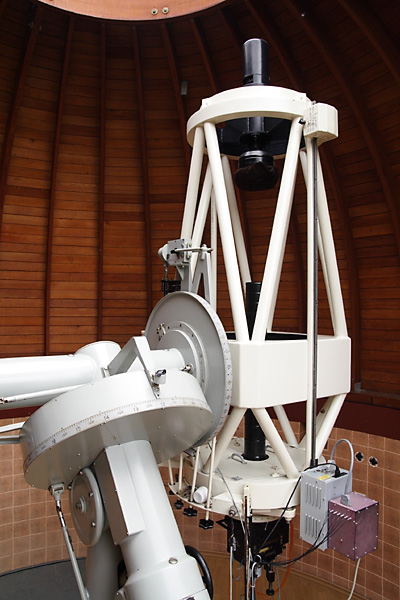Serrurier Truss on:
[Wikipedia]
[Google]
[Amazon]
 A Serrurier
A Serrurier
File:Palomar arp 600pix.jpg,
astro.caltech.edu - Reflecting Telescopes
Optical telescope components Articles containing video clips {{Astronomy-stub ja:トラス#セルリエトラス
 A Serrurier
A Serrurier truss
A truss is an assembly of ''members'' such as beams, connected by ''nodes'', that creates a rigid structure.
In engineering, a truss is a structure that "consists of two-force members only, where the members are organized so that the assembl ...
is used in telescope
A telescope is a device used to observe distant objects by their emission, absorption, or reflection of electromagnetic radiation. Originally meaning only an optical instrument using lenses, curved mirrors, or a combination of both to observe ...
tube assembly construction. The design was created in 1935 by engineer Mark U. Serrurier when he was working on the Mount Palomar
Palomar Mountain ( ; es, Monte Palomar ) is a mountain ridge in the Peninsular Ranges in northern San Diego County. It is famous as the location of the Palomar Observatory and Hale Telescope, and known for the Palomar Mountain State Park.
His ...
Hale telescope
The Hale Telescope is a , 3.3 reflecting telescope at the Palomar Observatory in San Diego County, California, US, named after astronomer George Ellery Hale. With funding from the Rockefeller Foundation in 1928, he orchestrated the planning, de ...
.Encyclopedia of Astronomy and Physics, "Reflecting Telescopes", Paul Murdin and Patrick Moore The design solves the problem of truss flexing by supporting the primary objective
Objective may refer to:
* Objective (optics), an element in a camera or microscope
* ''The Objective'', a 2008 science fiction horror film
* Objective pronoun, a personal pronoun that is used as a grammatical object
* Objective Productions, a Brit ...
mirror and the secondary mirror by two sets of opposing trusses before and after the declination
In astronomy, declination (abbreviated dec; symbol ''δ'') is one of the two angles that locate a point on the celestial sphere in the equatorial coordinate system, the other being hour angle. Declination's angle is measured north or south of the ...
pivot. The trusses are designed to have an equal amount of flexure, which allows the optics to stay on a common optical axis
An optical axis is a line along which there is some degree of rotational symmetry in an optical system such as a camera lens, microscope or telescopic sight.
The optical axis is an imaginary line that defines the path along which light propagat ...
. When flexing, the "top" truss resists tension
Tension may refer to:
Science
* Psychological stress
* Tension (physics), a force related to the stretching of an object (the opposite of compression)
* Tension (geology), a stress which stretches rocks in two opposite directions
* Voltage or el ...
and the "bottom" truss resists compression
Compression may refer to:
Physical science
*Compression (physics), size reduction due to forces
*Compression member, a structural element such as a column
*Compressibility, susceptibility to compression
*Gas compression
*Compression ratio, of a c ...
. This has the effect of keeping the optical elements parallel to each other. The net result is all of the optical elements stay in collimation
A collimated beam of light or other electromagnetic radiation has parallel rays, and therefore will spread minimally as it propagates. A perfectly collimated light beam, with no divergence, would not disperse with distance. However, diffraction pr ...
regardless of the orientation of the telescope.
Some Serrurier truss designs end the truss members with a short flexible rod creating a more ideal "parallel motion flexure" system, to allow maximum parallelism of optical elements under gravitational load. Since truss members work primarily in tension and compression, there is no appreciable loss of stiffness due to the bending of the end flexures.
Certain designs used by amateur telescope makers, specifically truss tube Dobsonian
A Dobsonian telescope is an altazimuth-mounted Newtonian telescope design popularized by John Dobson in 1965 and credited with vastly increasing the size of telescopes available to amateur astronomers. Dobson's telescopes featured a simplified ...
s that use a single truss, are sometimes called "Serrurier truss" designs. These single truss designs are used for their rigidity and do perform the function of keeping the optical elements parallel, but since they lack the opposing truss that keeps optics on the same optical axis they are not technically "Serrurier trusses".
Other examples of Serrurier truss designs:
Hale telescope
The Hale Telescope is a , 3.3 reflecting telescope at the Palomar Observatory in San Diego County, California, US, named after astronomer George Ellery Hale. With funding from the Rockefeller Foundation in 1928, he orchestrated the planning, de ...
Image:Forststernwarte Jena 50cm-Cassegrain 2.jpg, Forststernwarte Jena
Image:Mayall Telescope.jpg, Serrurier truss used on the Mayall Telescope
The Nicholas U. Mayall Telescope, also known as the Mayall 4-meter Telescope, is a four-meter (158 inches) reflector telescope located at the Kitt Peak National Observatory in Arizona and named after Nicholas U. Mayall. It saw first light on F ...
.
Image:Serrurier truss under load (side view).ogg, Animation of a Serrurier truss under load
Image:Serrurier truss under load (slanted view).ogg, Animation of a Serrurier truss under load, slanted view
See also
*List of telescope parts and construction Hardware Accessories
*Finderscope
*Iron sight
* Reflector (reflex) sight
* Cheshire collimator: A simple tool to collimate a telescope
Control
*Clock drive
*GoTo
Mechanical construction
*Mirror support cell
*Serrurier truss
*Silvering
Mounts
*Te ...
Footnotes
References
*Learner, Richard. "The Legacy of the 200-inch", ''Sky&Telescope'', April 1986, pp. 349–353 *Diffrient, Roy. "Flexure of a Serrurier Truss", ''Sky&Telescope'', February 1994, pp. 91–94astro.caltech.edu - Reflecting Telescopes
Optical telescope components Articles containing video clips {{Astronomy-stub ja:トラス#セルリエトラス